When you think of Cajun food, Chicken Sauce Piquante should come to mind. A traditional Cajun recipe with a unique flavor of chicken smothered in a spicy roux-based sauce made with the Trinity, tomatoes, and a South Louisiana bite. Slowly simmered, this one-pot dish is served over rice and can feed a crowd. Sweet Daddy D's Chicken Sauce Piquante recipe, is simple, no-angst, and extraordinarily delicious.
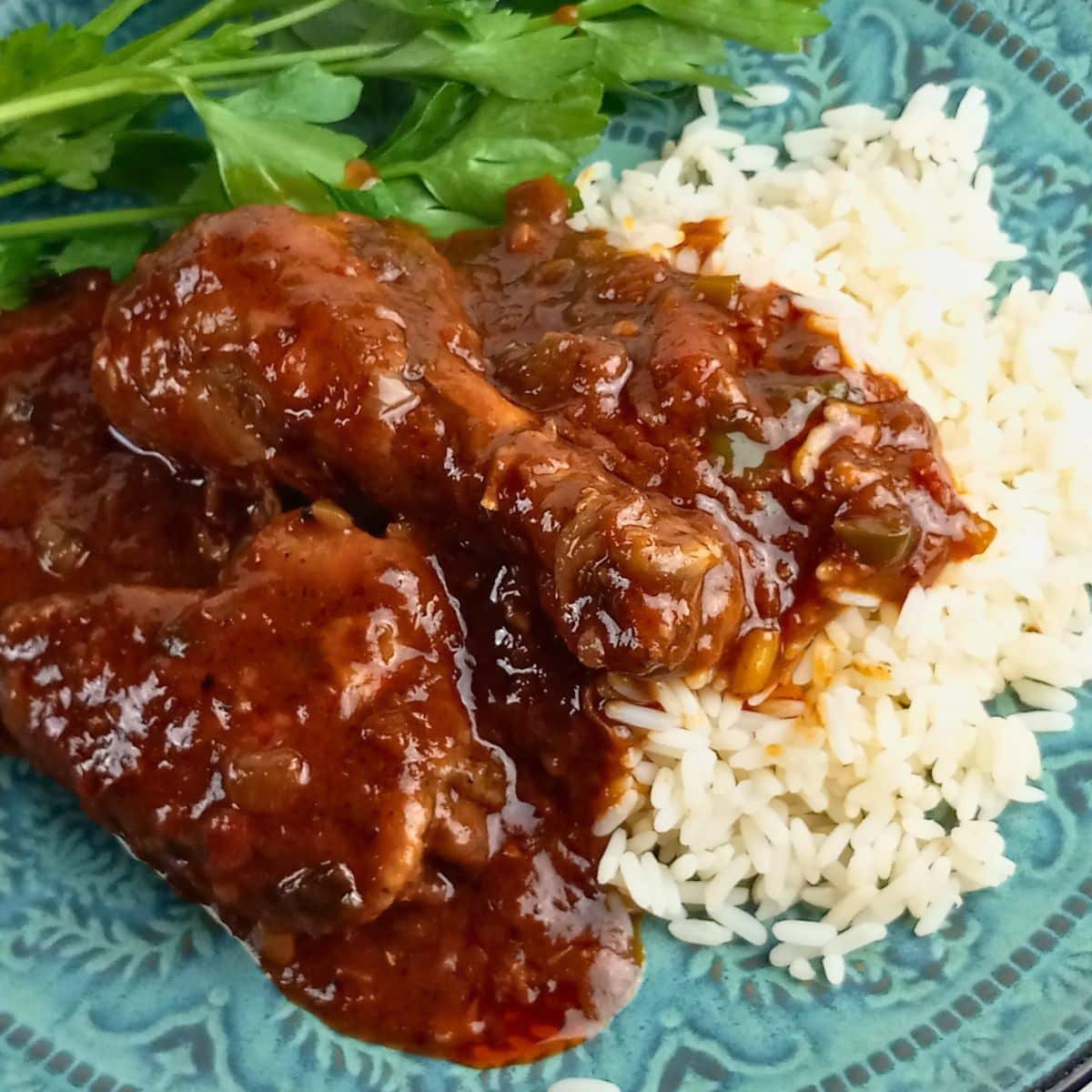
This post is not sponsored, but you will find affiliate links on this page. As an Amazon Associate, I earn from qualifying purchases. The price you pay as a consumer does not change, but I may make a small commission based on your purchase.
Jump to:
What is Sauce Piquante?
Sauce Piquante is a popular Cajun dish, with influences of Creole Cuisine being very apparent. It's been said that Sauce Piquante is the Cajun version of Sauce Creole but with some distinct differences.
- Cajun cuisine developed from a French foundation, so a roux is a natural component.
- The use of tomatoes is likely the influence of West African slaves or Italian immigrants to South Louisiana.
- The peppers and spiciness are the influence of Spanish and Caribbean cuisines, which are also an important component of Creole cuisine.
- The one-pot slow cooking process and the use of tougher cuts of meats or proteins is a Cajun cuisine characteristic.
The term piquante (or piquant, depending on where you see it) comes from the French and refers to a taste sensation like having “a sticker in your tongue”. To define Piquante, I have seen terms like prickly, sharp, bristly, hot, pungent, and sharp.
“creating a prickly sensation in the mouth”
Larousse Gastronomique, The World’s Greatest Culinary Encyclopedia
What makes a good Sauce Picante?
The best Sauce Piquant recipes are known for a depth of flavor that is more complex than spicy, produced by a layering of various peppers. The best results come from home cooks who can spend the time to coax the best flavors from generational recipes. The best Sauce Piquantes share some common traits:
- An agreeable, stimulating flavor that can be spicy, tangy, and peppery.
- The spiciness should be part of a complex and unique flavor profile, totally controlled by the cook, and should not overpower the other flavors.
- Some recipes use lemon or vinegar to add acidity and tanginess to the flavor profile.
- Use a variety of peppers (black pepper, white pepper, jalapenos, cayenne pepper, and pepper flakes) to release their flavor over time.
- An important component of the depth of flavor is created by "browning" the tomato paste along with the roux and Trinity.
- Proteins that require a long cooking time to tenderize.
Sign up for my email notifications of new recipes and posts right HERE.
Here’s What You Need
Here are the main ingredients. The printable recipe card below lists all ingredients and quantities.
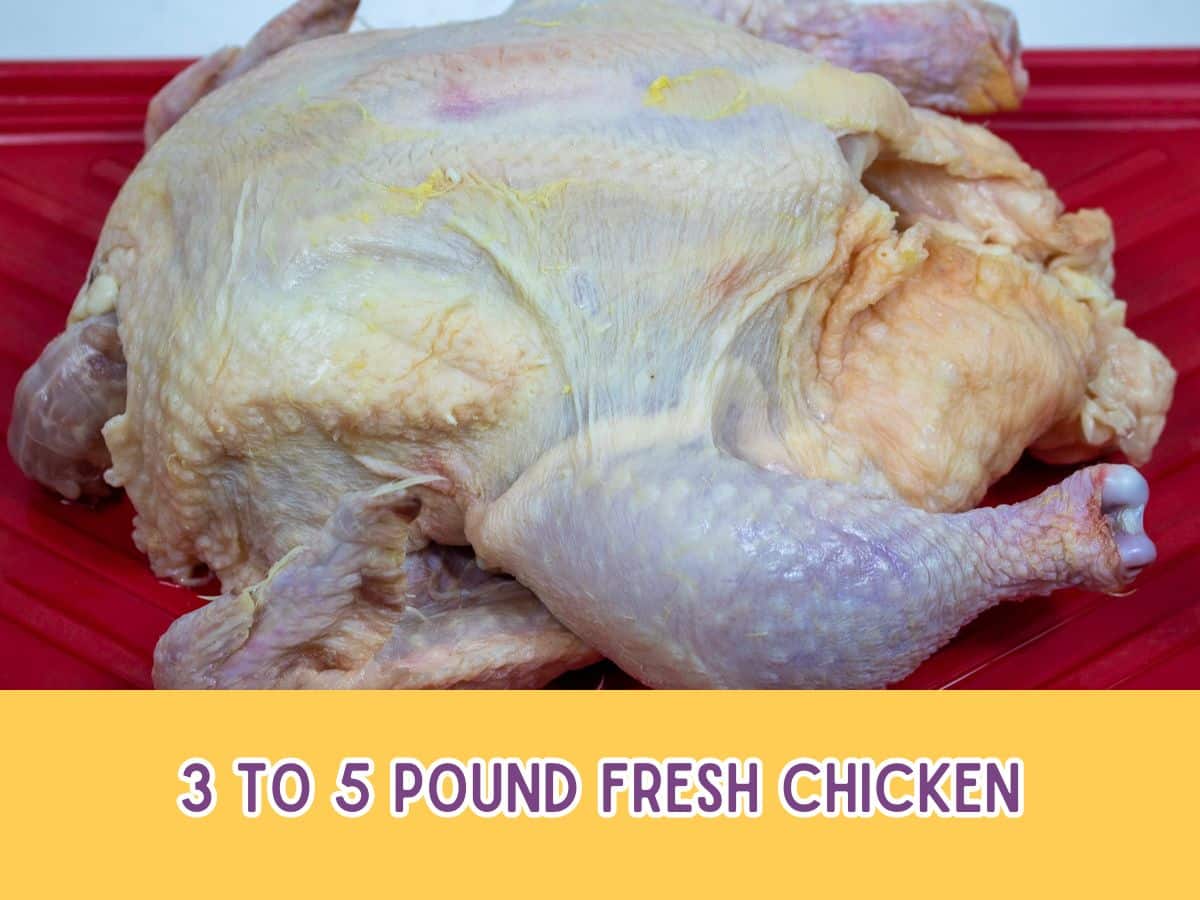
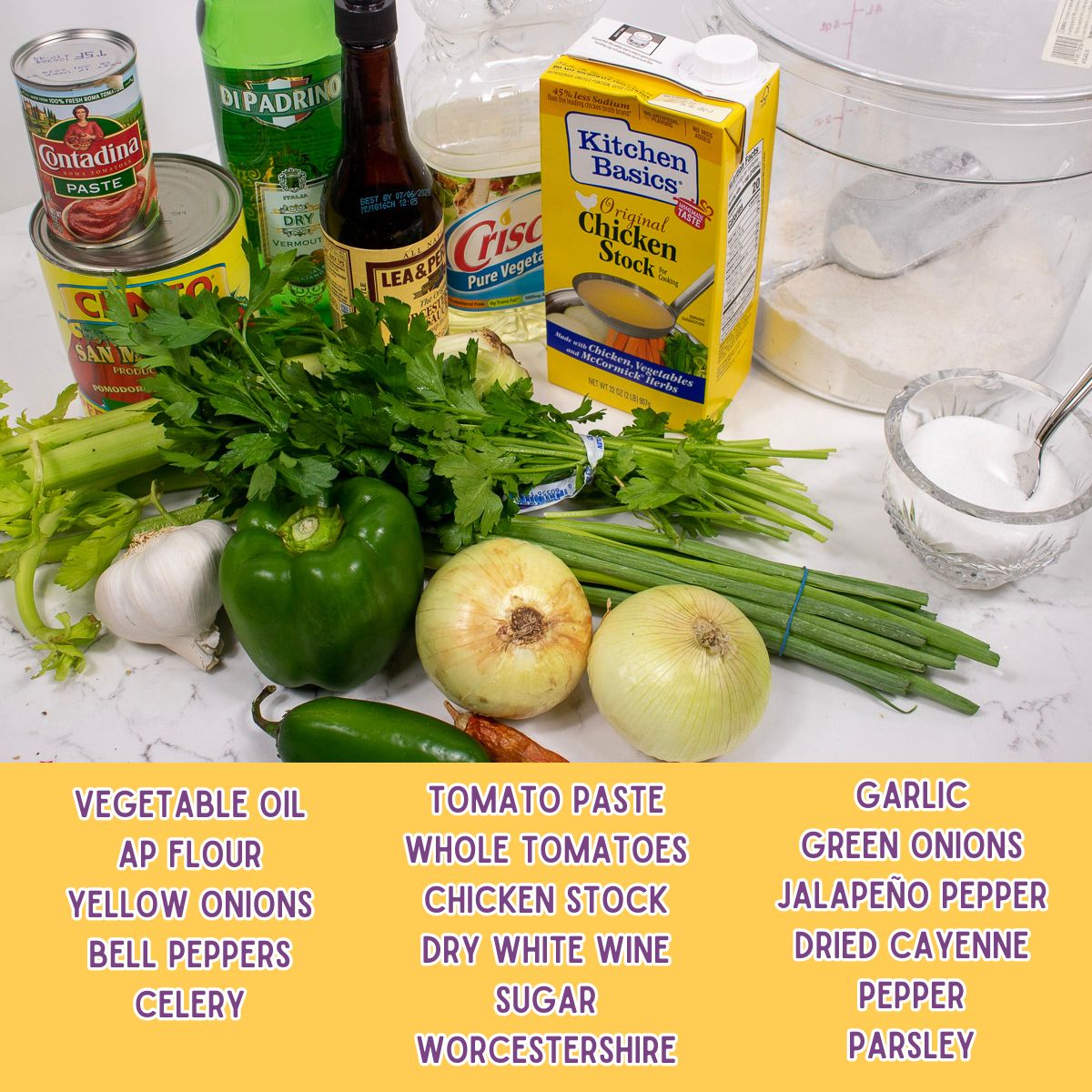
What is the Trinity?
In South Louisiana culinary parlance, the Trinity or Holy Trinity refers to the combination of yellow onion, bell pepper, and celery. The combination of these particular vegetables provides the underlying flavor foundation for many Creole and Cajun dishes in the same manner that mirepoix, soffrito, and sofrito do in French, Italian, and Spanish recipes. Many cuisines use foundational vegetables to provide complexity and deep flavor for many dishes.
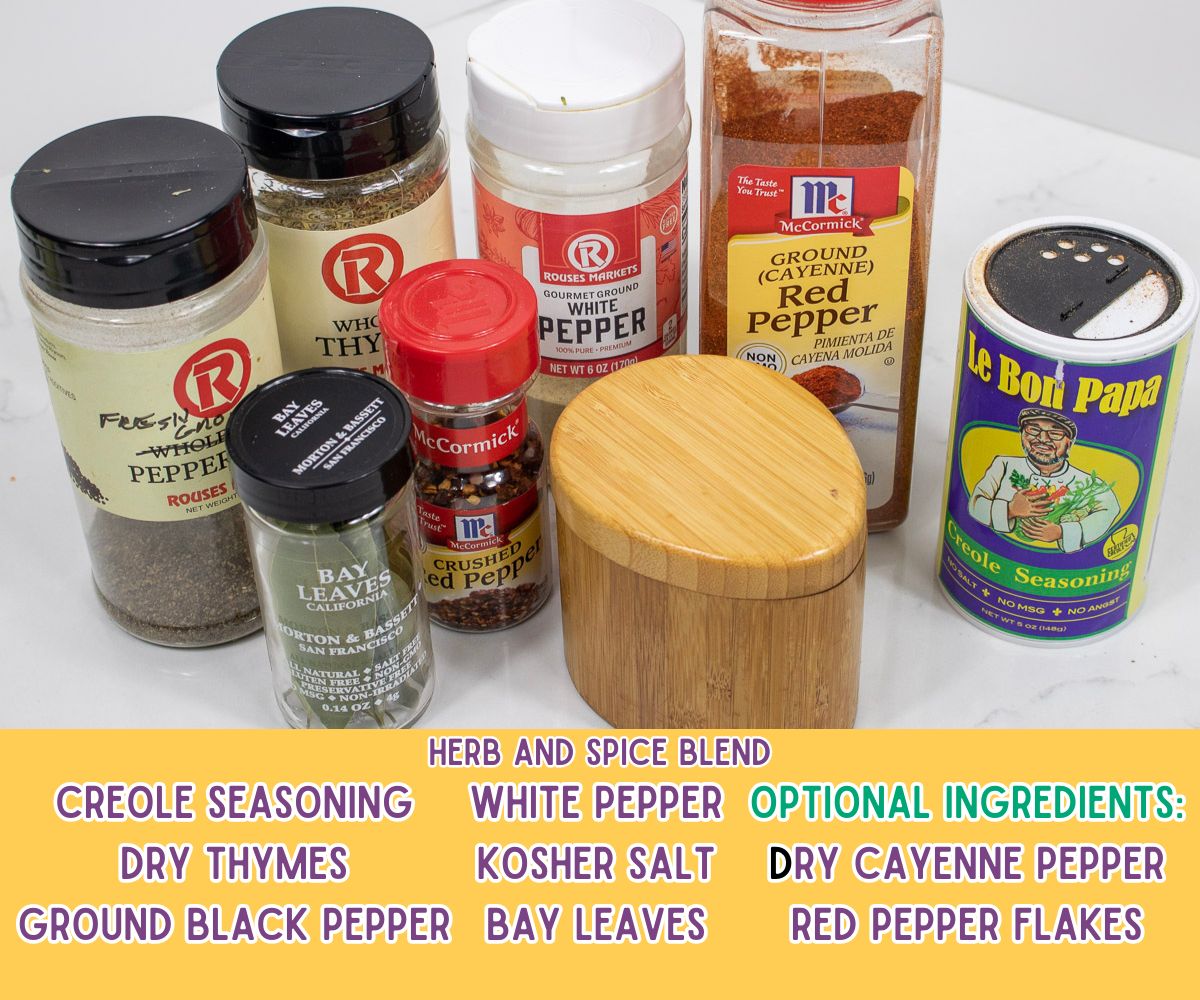
Ingredient Notes
- Chicken: I use a whole chicken cut into 10 pieces. The breasts are cut in two so that all the pieces are relatively the same size. A whole chicken gives you some white meat as well as dark meat, but a chicken that is already cut into pieces can give you the same. If you buy pre-cut chicken, you could use all white or all dark. Leg-quarters (with the thigh) are perfect for this recipe. Check the Mise En Place section below for preparing the chicken.
- Fat: I use vegetable oil to brown the chicken and make the roux. Vegetable oil is neutral in flavor, but you can also substitute butter, bacon drippings, or lard for additional flavor.
- Peppers: Peppers are essential to this recipe. I use a variety of peppers to provide a more complex flavor: black pepper, white pepper, fresh Jalapenos, cayenne pepper (both dried whole and powdered), and red pepper flakes. You can adjust the level of spiciness by increasing or decreasing the amount of pepper you use.
- Wine: For Chicken Sauce Piquante I use a dry white wine. If I were making Seafood Sauce Piquant, I would do the same. For Turtle Sauce Piquante I would use Dry Red Wine and for Rabbit I would use either White or Red.
- Stock: For Chicken Sauce Piquante I use chicken stock. For Seafood Sauce Piquant I would use seafood stock and for Turtle Sauce Piquante I would use Turtle, Veal, or beef stock. I would use Rabbit or Veal Stock for Rabbit Sauce Piquant. For any type of Sauce Piquante, I would not hesitate to use Chicken Stock if I didn't have the specific stock I wanted. Check out my recipe for Homemade Chicken Stock.

Equipment
This recipe does not require any special equipment. A Dutch oven is perfect for the long simmer this recipe requires and I've found these prep trays great for preparing the chicken. Other than that, the usual prep equipment is all you need.
Hints and Tips (FAQs)
Leftovers can be held in the refrigerator for 3 to 5 days and in the freezer for up to 6 months. Always use an airtight container to maintain optimal quality. Defrost frozen Sauce Piquant in the fridge overnight or in cold water that is changed often. Reheat in a saucepan on the stove over medium heat until the chicken pieces are warmed through. You can also reheat leftovers in a microwave, but be careful not to nuke the chicken into bricks!
Nope, you can use individual pieces. The bone-in chicken provides the most flavor, but boneless-skinless chicken also works. If you use individual pieces (bone-in or boneless), you can choose to use all breasts, all thighs, leg-quarters, or any combination of pieces.
Chicken Sauce Piquante is one of many variations of this dish. It’s common to see Turtle, Rabbit, Alligator, and various seafood (among other proteins) in Sauce Piquante recipes. Cajuns would use whatever was available from hunting, fishing, or growing. Most Sauce Piquante recipes are best with tougher proteins that respond well to slow simmers. The method would be the same, but depending on the protein, I would align the flavor of the stock and the type of wine I use.
Here’s What You Do
First…you have a beer. This is a straightforward recipe, but you will find it easier and have better results if you prepare yourself and the ingredients beforehand. Grab a beer and read the recipe all the way through. Learn what equipment you need, what ingredients go into this dish, and what you will do with each. Perform your mise en place so everything is laid out and you are ready to assemble the recipe. If you do this, the cooking process will be simple and fun!
Mise en Place
1. Prepare the chicken
2. Season the chicken
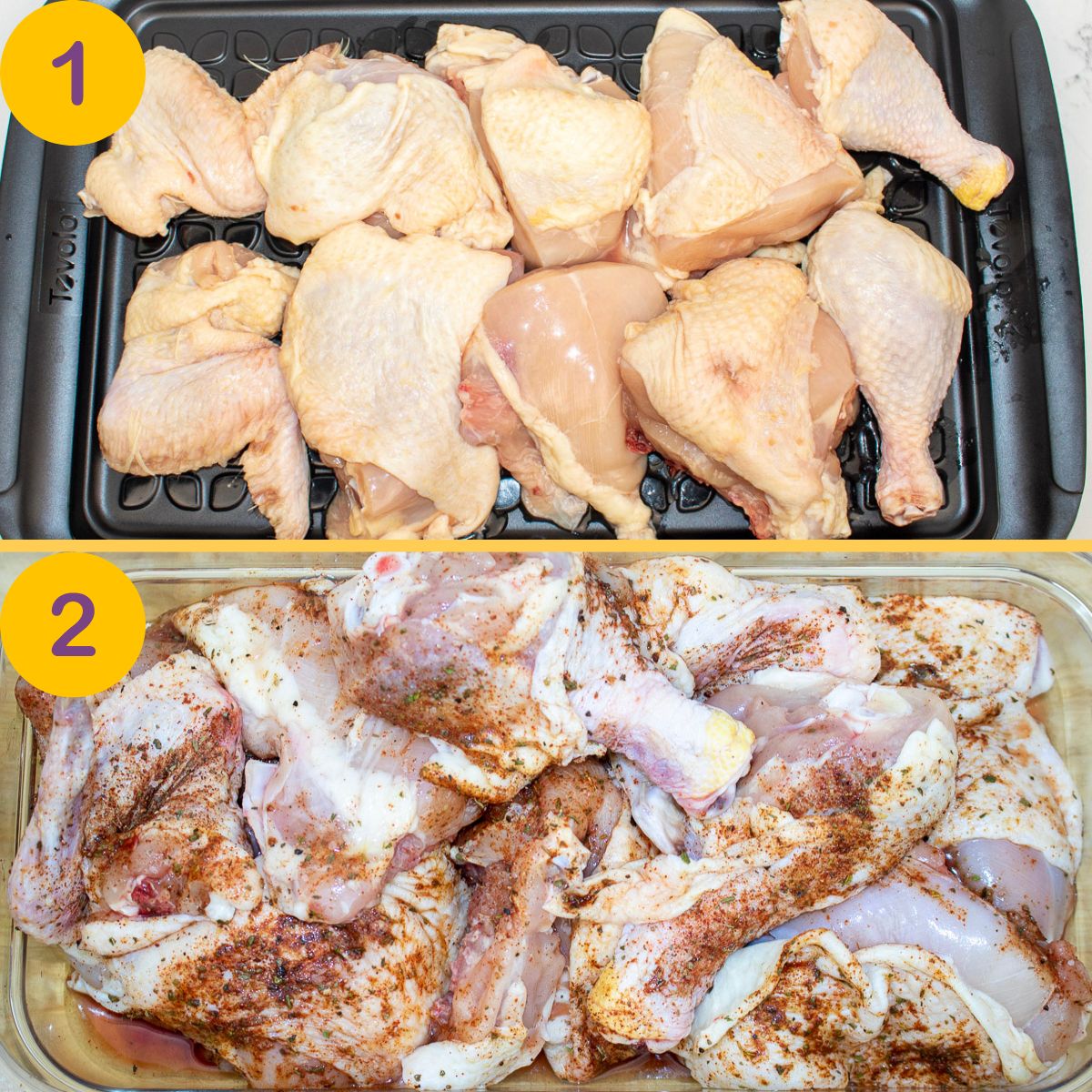
- Cut a whole chicken into 10 pieces by cutting the breasts in half. This is done so that all the pieces are relatively the same size.
- If you are using precut pieces, trim excess fat and skin, and cut breasts in half.
- Rinse the chicken and pat dry with a paper towel.
- Sprinkle the pieces with kosher salt and a generous amount of Creole seasoning.
- Place the seasoned chicken in the refrigerator, uncovered. This will allow the skin to dry a little which helps when browning.
Lagniappe Tip: Save the leftover chicken parts (neck, backbone) to make stock. These pieces can be frozen to use later if necessary.
3. Prepare the remaining ingredients
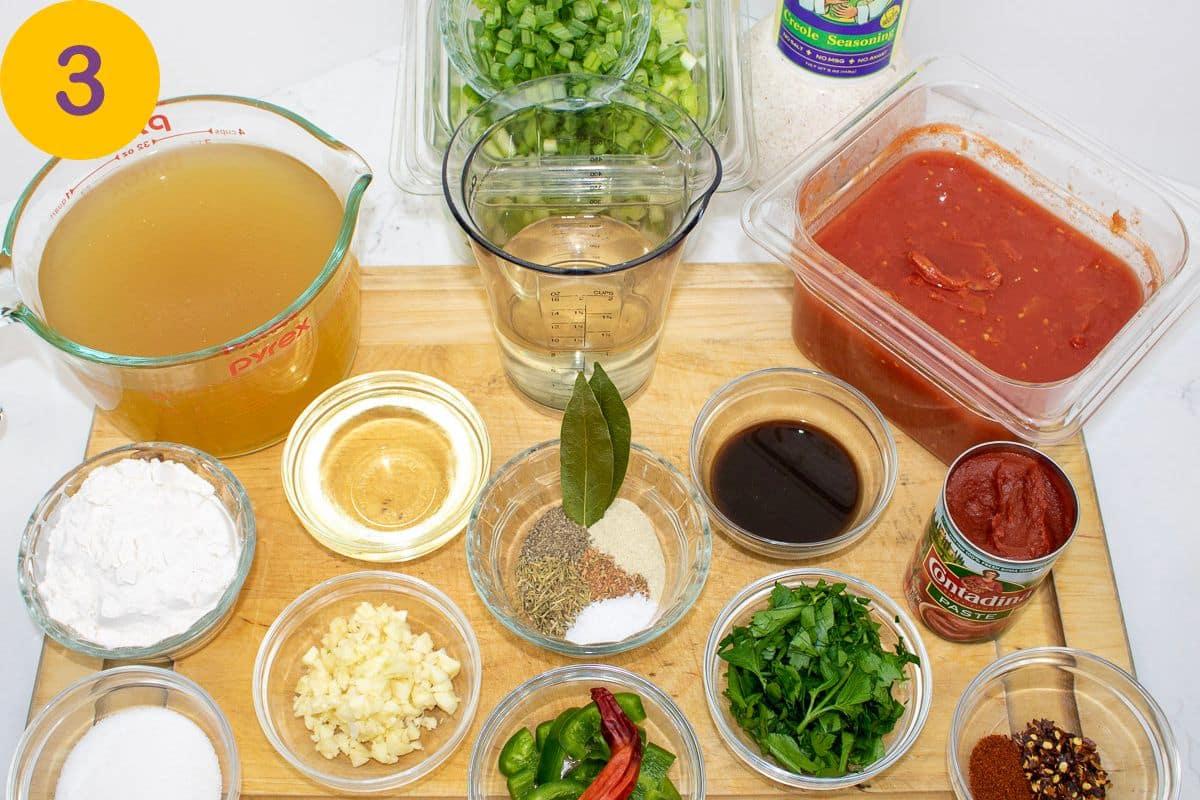
- Since this recipe should be fairly rustic and will simmer for a long time, roughly chop the yellow onions, bell peppers, and celery (the Trinity). Place these all in the same prep bowl.
- Rough chop the garlic and parsley then slice the green onions. Place those in individual prep bowls.
- Measure the remaining ingredients: vegetable oil, AP flour, wine, stock, sugar, and Worcestershire.
- Pour the whole tomatoes with their juice into a large prep bowl and crush them with your hands or a potato masher. Of course, if you are using diced tomatoes, there's no need to crush them.
- Open the can of tomato paste.
- Combine the Herb and Spice Blend in a prep bowl.
Lagniappe Tip: I usually separate the cayenne and pepper flakes from the Herb and Spice Blend because I rely on the flavor of the sauce to tell me how much of those to use.
Now you're ready, how's your beer?
Create the First Layer of Flavor
What happens in this step? The first layer of flavor! Even though the chicken will simmer in the sauce for hours, browning the chicken first will leave fond in the Dutch oven contributing a deep flavor to the whole recipe. That flavor carries through to the roux and the Trinity for a deep flavor foundation.
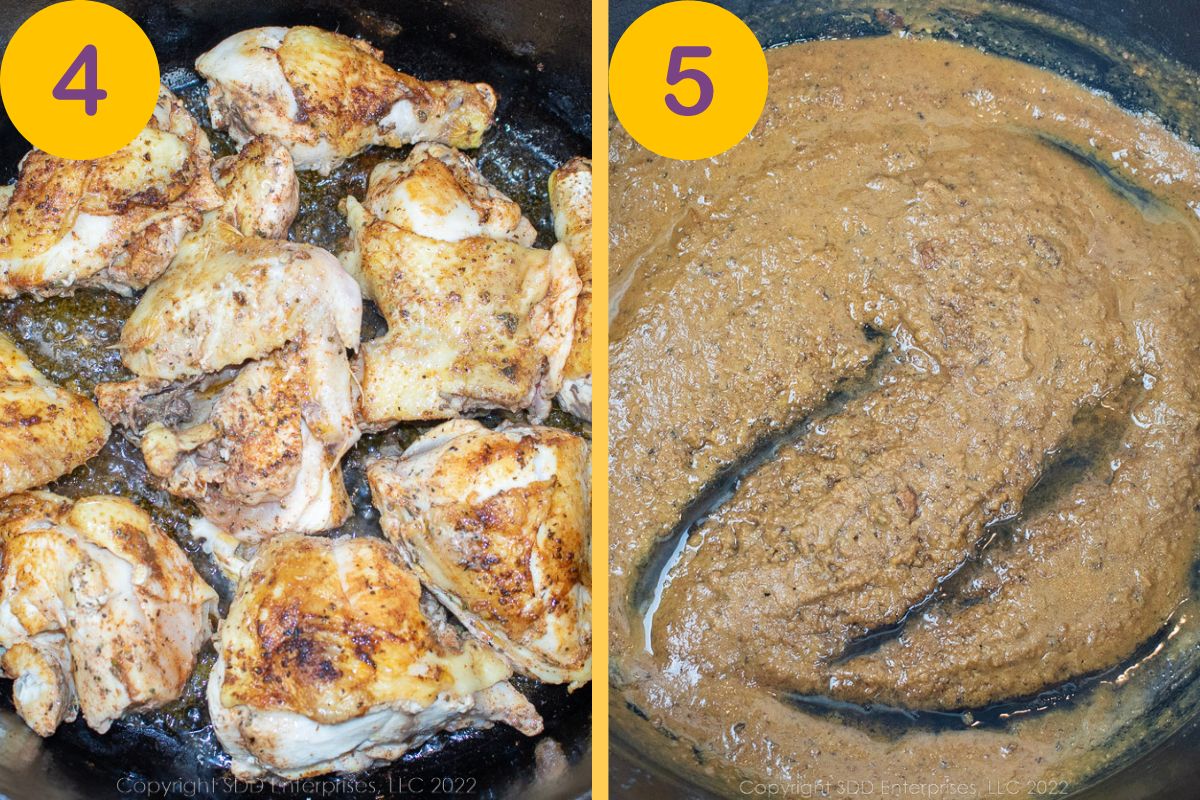
- Heat 2 tablespoons of vegetable oil in a Dutch oven over medium-high heat. When the oil is shimmering, add the chicken pieces skin-side down and brown for about 4 minutes on each side. Remove the browned chicken from the Dutch oven and set it aside.
- After removing all the chicken, lower the heat to medium and add ¾ cup of vegetable oil. When the oil starts to shimmer, add the flour. Whisk or stir for about 8 to 10 minutes to make a dark roux. Be sure to scrape the fond from the bottom of the Dutch oven from browning the chicken. This will add a lot of flavor to the roux.
Lagniappe Tip: As an option, remove the skin from the browned pieces before adding them back to the sauce. The skin has done its job of flavoring the roux and will only get soggy during a long simmer.
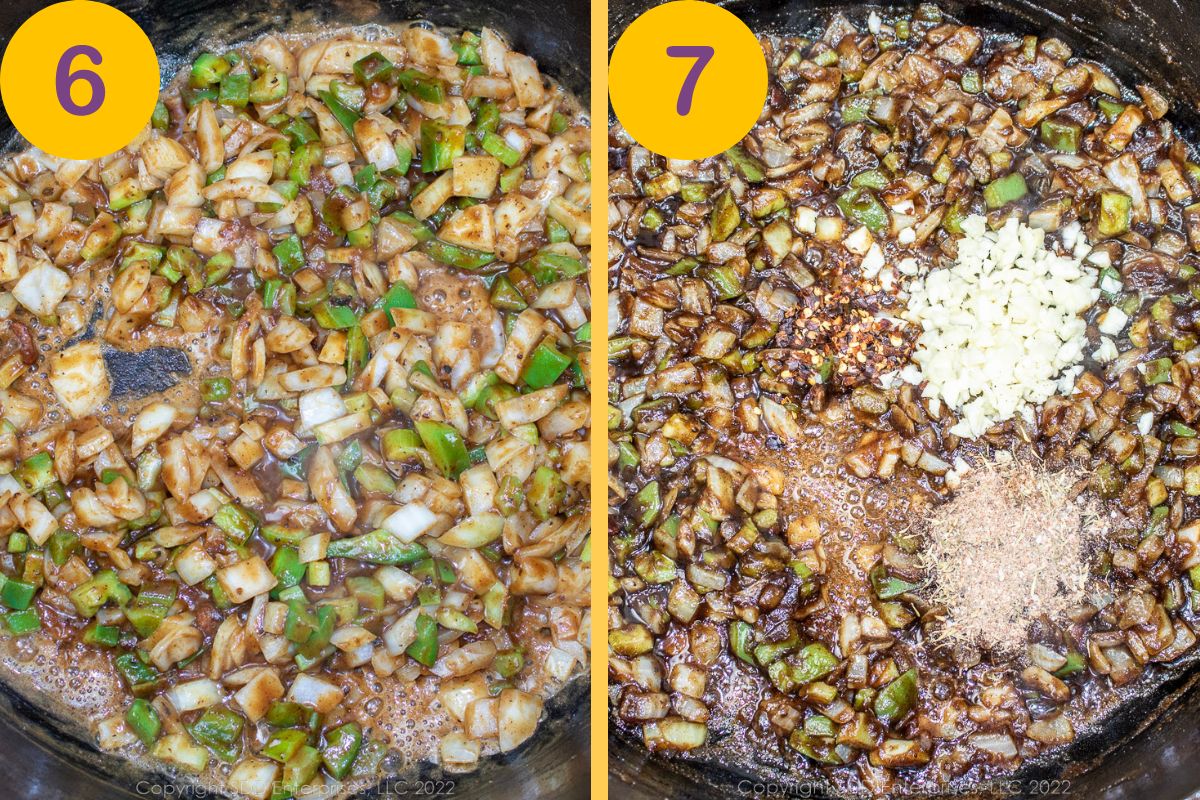
- When the roux is almost the color you want, remove the Dutch oven from the heat and add the Trinity. Saute, stirring almost constantly until the onions are softened and translucent. Return the Dutch oven to the heat after 2 or 3 minutes and finish cooking the Trinity for a total of about 8 minutes
- Next, add the garlic, some red pepper flakes, and about ½ the Herb and Spice Blend (not the Bay Leaves yet). Continue to saute until aromatic, which will only take about 2 minutes.
Build the Tomato-based Sauce
What happens in this step? Now we create the sauce that carries the piquante flavor throughout the dish.
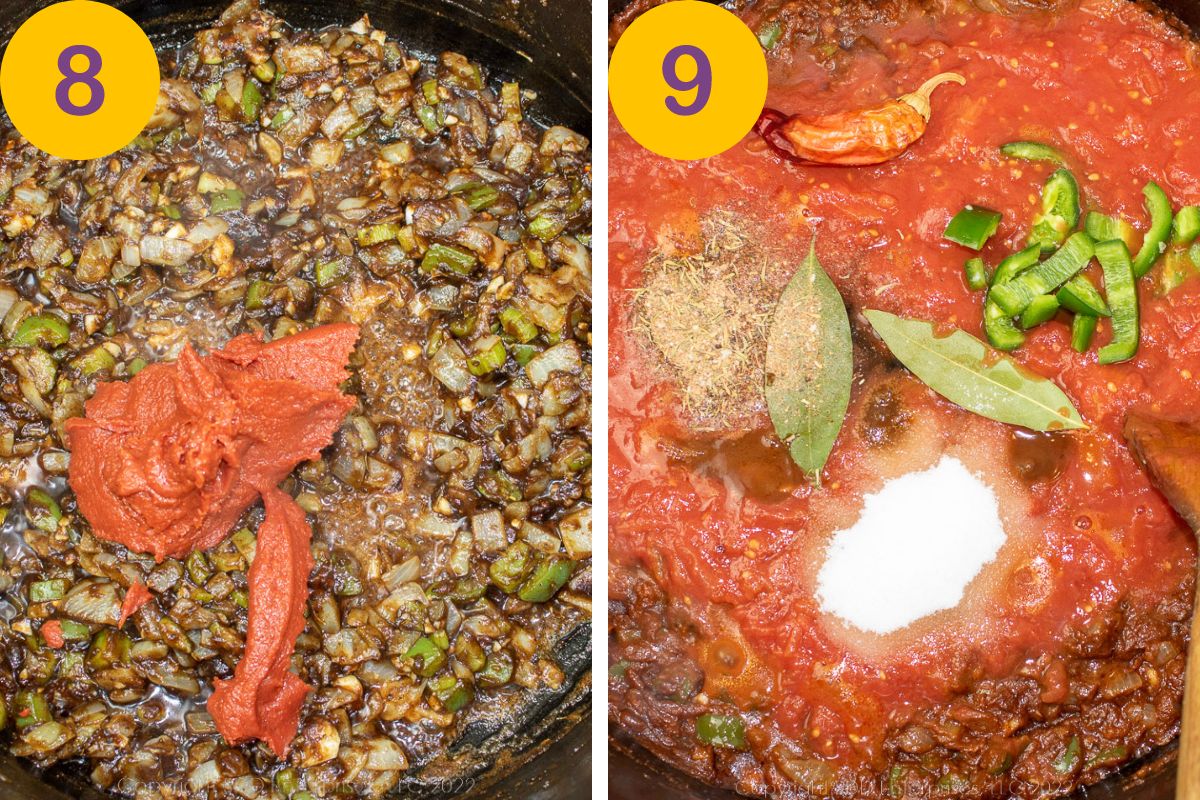
- Maintaining medium heat, stir the tomato paste into the roux mixture and saute for 5 to 8 minutes, while the tomato paste browns slightly. Stir this frequently so that it does not stick.
- Add the wine and mix thoroughly. Saute for another 5 minutes until the wine has incorporated into the tomato paste. Make sure to scrape up any fond left on the bottom and stir that into the sauce. Next, add the crushed whole tomatoes and their sauce, Worcestershire sauce, sugar, about ½ of the remaining Herb and Spice Blend, the jalapeno, the whole dry cayenne pepper, and the bay leaves. Mix thoroughly and simmer for about 5 minutes.
Lagniappe Tip: Allow enough time for the tomato paste to brown slightly. The rich, dark red color created during this process reflects the deep flavor we are building. The flavor created will be more complex than just warming the tomato paste.
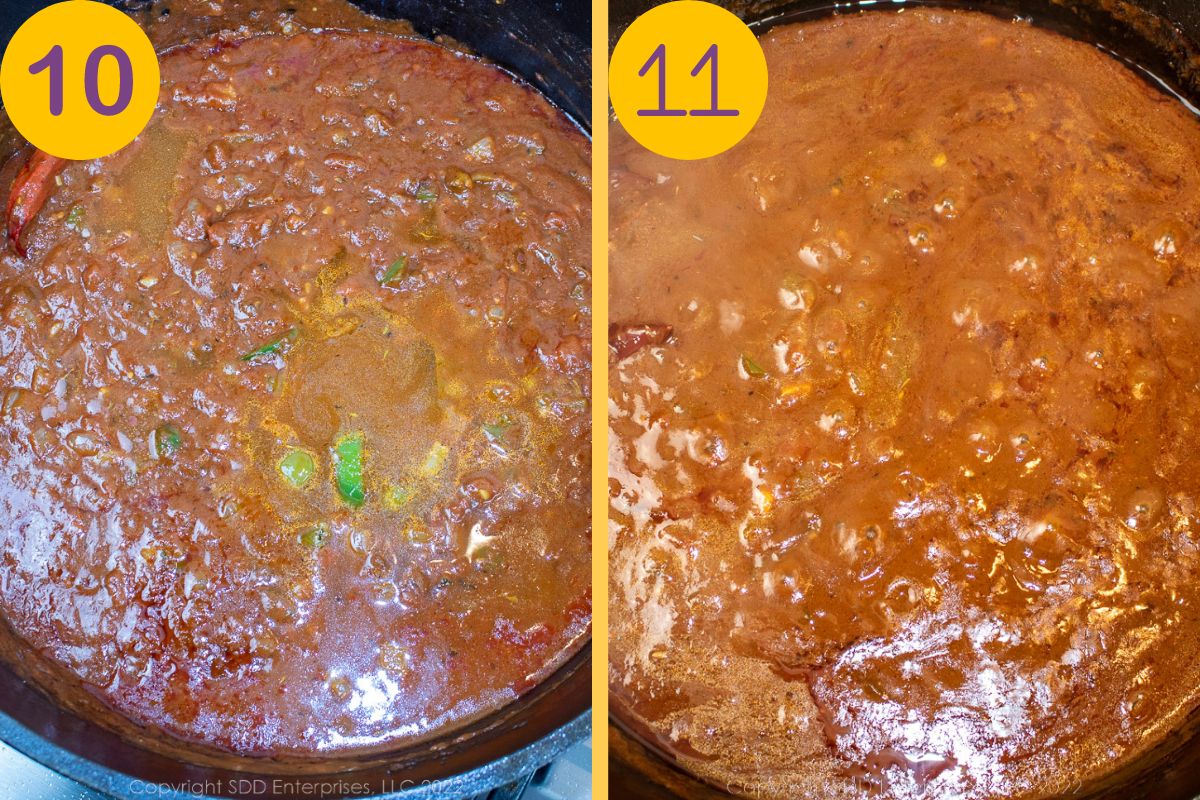
- Increase the heat to medium-high and add the stock. Stir well.
- When the sauce reaches a low boil, reduce the heat and continue on a slight simmer for about 45 minutes. Partially cover the Dutch oven and stir occasionally.
Smother the Chicken in the Sauce
What happens in this step? To achieve its optimal flavor, the sauce needs to simmer for a long time. This also tenderizes the chicken and allows the flavors to meld into a delicious outcome.
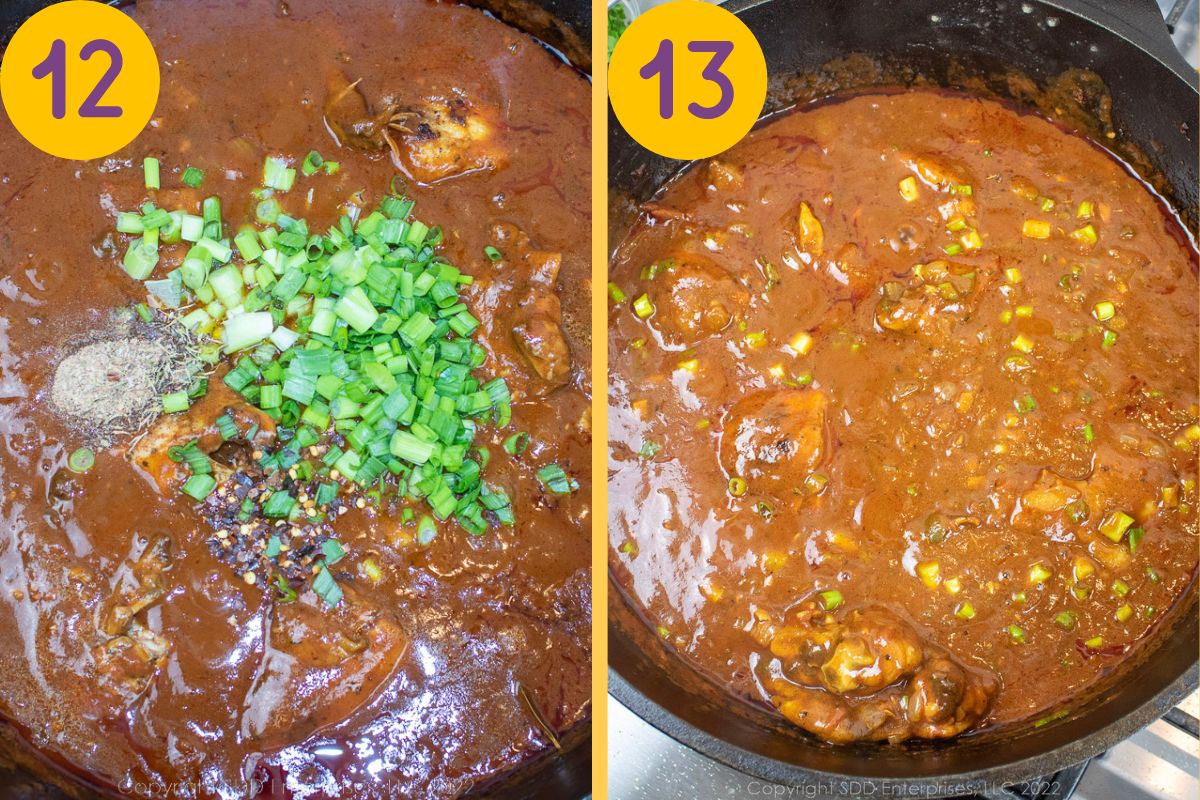
- Add the browned chicken (including any accumulated juice), the remaining Herb and Spice Blend, and the green onions (reserve some to garnish the top at the end) and combine well.
- Continue to simmer for about 2 hours, stirring occasionally. Cover the Dutch oven for the first 30-45 minutes, then remove the lid completely or set it ajar as the sauce thickens.
Lagniappe Tip: You'll want the sauce to thicken, so use the lid to help that along. Place the lid on to slow the thickening, remove the lid to speed up thickening, and place the lid ajar to slowly thicken.
When the chicken is tender, it is done. Taste the sauce and add any salt and seasonings you’d like.
Lagniappe Tip: I use a bamboo skewer to test tenderness. A fork or thin knife will also do the trick.
Sign up for my email notifications of new recipes and posts right HERE.
Serving Suggestions
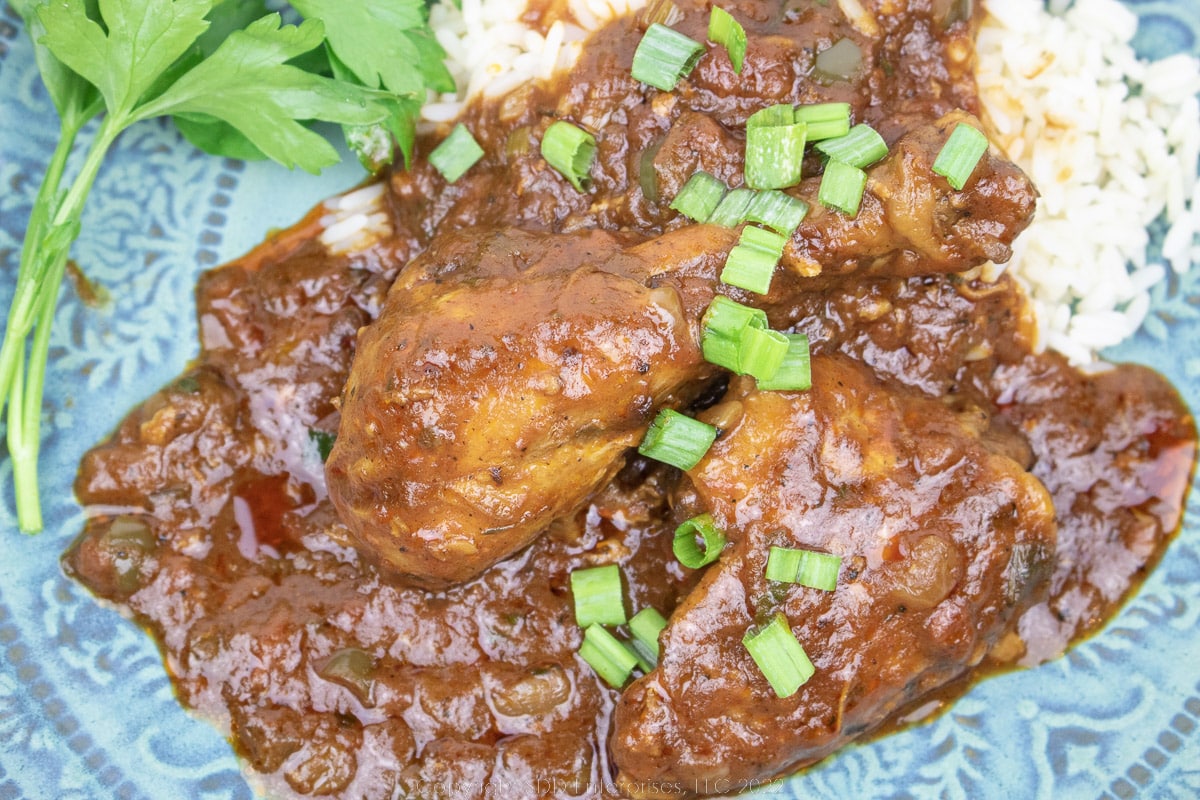
Chicken Sauce Piquant should be served over rice and garnished with chopped parsley or green onions. A green salad, like this Sensation Salad, is a perfect companion. Here are some great side dishes that pair perfectly with Chicken Sauce Piquante:
Smother them with LOVE! Here are some other great Cajun recipes from Sweet Daddy D!
If you make this recipe:
- Tell us about it in the Comments section below
- LEAVE A RATING ON THE RECIPE-worthy of 5-Stars?
- Questions or Comments? that’s the place!
- SIGN UP FOR OUR EMAIL UPDATES so you don't miss anything!
- Post a picture and share it with your friends on our Social Media:
Yeah You Right!
Recipe
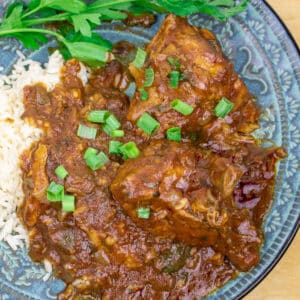
Chicken Sauce Piquante
Here's What You Need
- 1 whole Chicken (about 4 ½ pounds) Cut into 10 pieces See Notes
- ¾ cup Vegetable Oil divided (plus 2 tablespoons) or Bacon Grease
- ¾ cup AP Flour
- 2 cups Yellow Onions coarse chop
- 1 cup Bell Peppers coarse chop
- ½ cup Celery coarse chop
- 2 tablespoons Garlic about 5 cloves
- 6 ounces Tomato Paste
- 1 cup Dry White Wine
- 4 cups Chicken Stock
- 28 ounces Whole Tomatoes
- 1 Jalapeno Pepper See Notes
- 1 cayenne pepper (dried)
- 1 bunch Green Onions
- 3 tablespoons Sugar
- 2 tablespoons Worcestershire
- 4 tablespoons Parsley
Herb and Spice Blend
- 1 tablespoon Creole Seasoning plus some for chicken
- ½ teaspoon dry thyme
- ½ teaspoon kosher Salt
- ½ teaspoon ground black pepper
- ½ teaspoon white pepper
- 2 Bay Leaves
- ¼ teaspoon Cayenne pepper optional
- 1 teaspoon Crushed red pepper optional
Here's What You Do
- Cut the chicken into 10 pieces (See Notes). Season the chicken with Creole seasoning and place it in the refrigerator uncovered until needed.
- Heat about 2 tablespoons of the vegetable oil in a Dutch oven over medium-high heat. Brown the chicken pieces for about 4 minutes on each side. Remove the browned chicken from the Dutch oven and set it aside. See Notes.
- Lower the heat to medium and add the remaining oil. When shimmering, add the flour. Whisk or stir for about 5 to 8 minutes to make a dark roux.
- Remove the roux from heat and add the Trinity (yellow onions, bell peppers, and celery). Saute for about 8 minutes until the onions are softened and translucent. See Notes
- Next add the garlic, some of the red pepper flakes, and about ½ the Herb and Spice Blend (not the Bay Leaves yet). Continue to saute until aromatic, about 2 minutes.
- Maintaining medium heat, stir the tomato paste into the roux mixture and saute for about 5 to 8 minutes, while it browns slightly. Stir frequently so that it does not stick.
- Add the wine to the tomato paste and mix thoroughly. Saute another 5 minutes or so until the wine has incorporated into the tomato paste.
- Next, add the whole tomatoes (which you crushed by hand), Worchestershire sauce, sugar, about ½ of the remaining Herb and Spice Blend, the jalapeno, the whole cayenne pepper, and the bay leaves. Mix thoroughly and simmer for about 5 minutes.
- Increase the heat to medium-high and add the stock. Stir well, bring the mixture to a high simmer, then lower the heat and continue on a slight simmer for about 45 minutes. Partially cover the Dutch oven. Stir occasionally.
- Add the browned chicken (including any juice that has accumulated), the remaining Herb and Spice Blend, and the green onions (reserve some to garnish the top at the end) and combine well.
- Continue to simmer for about 2 hours, stirring occasionally. Cover the Dutch oven for the first 30-45 minutes, then remove the lid completely or set it ajar as the sauce thickens.
- When the chicken is tender, it is done. Taste the sauce and add any salt and seasonings you’d like.
- Serve over rice with crispy french bread and a green salad.

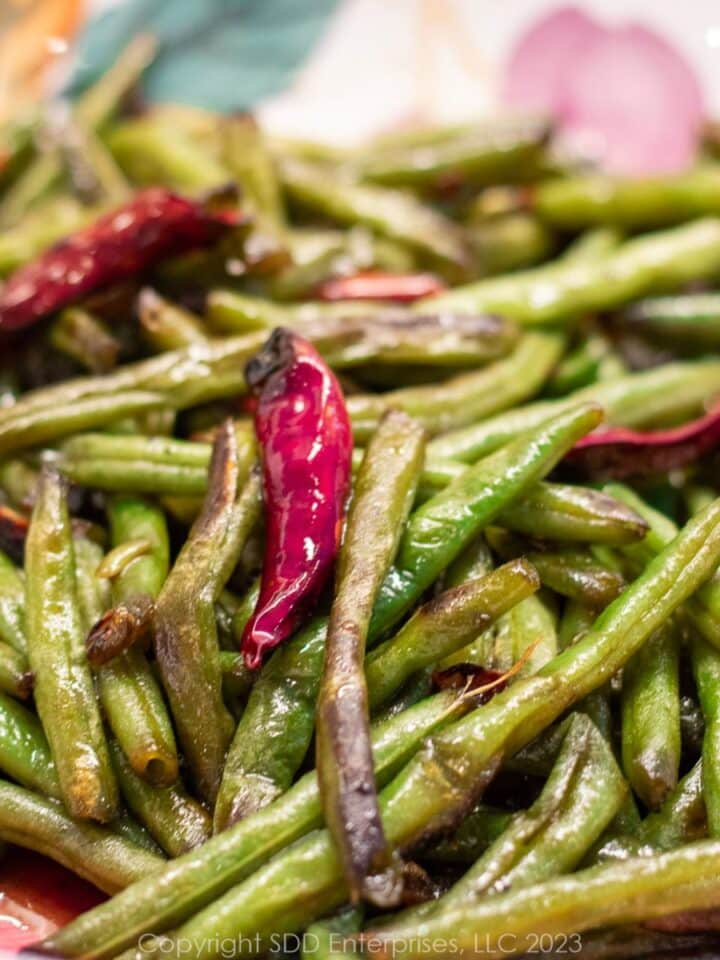
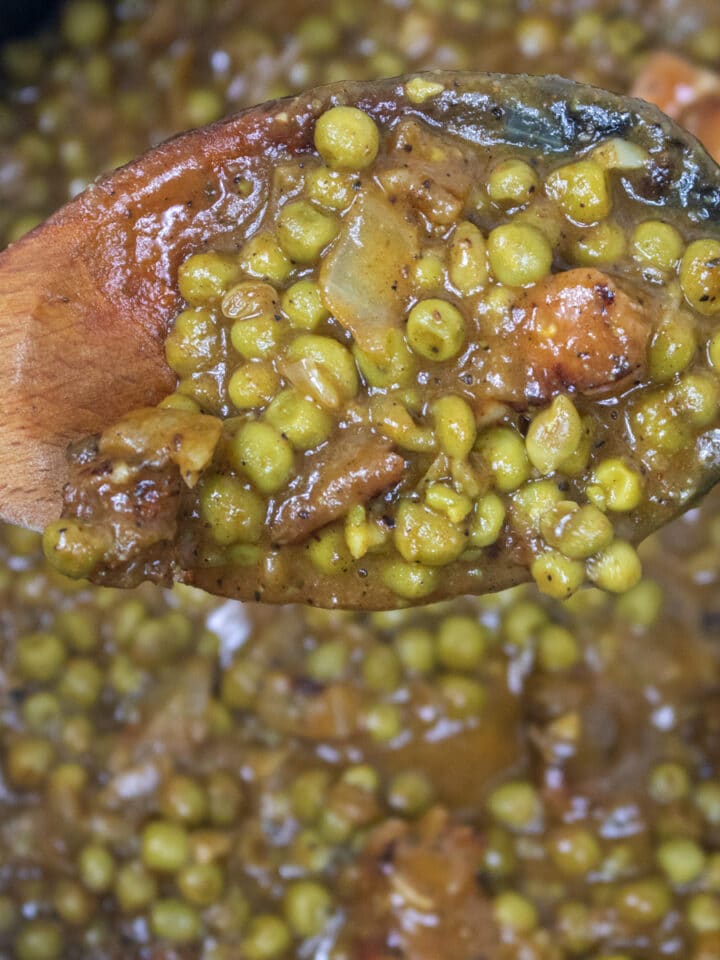
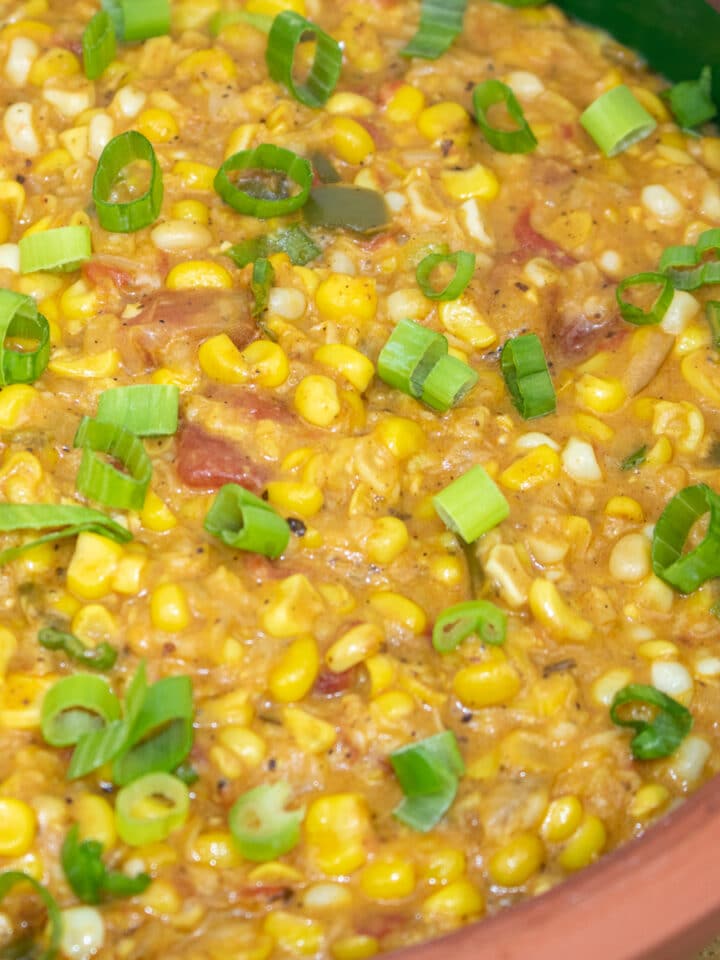
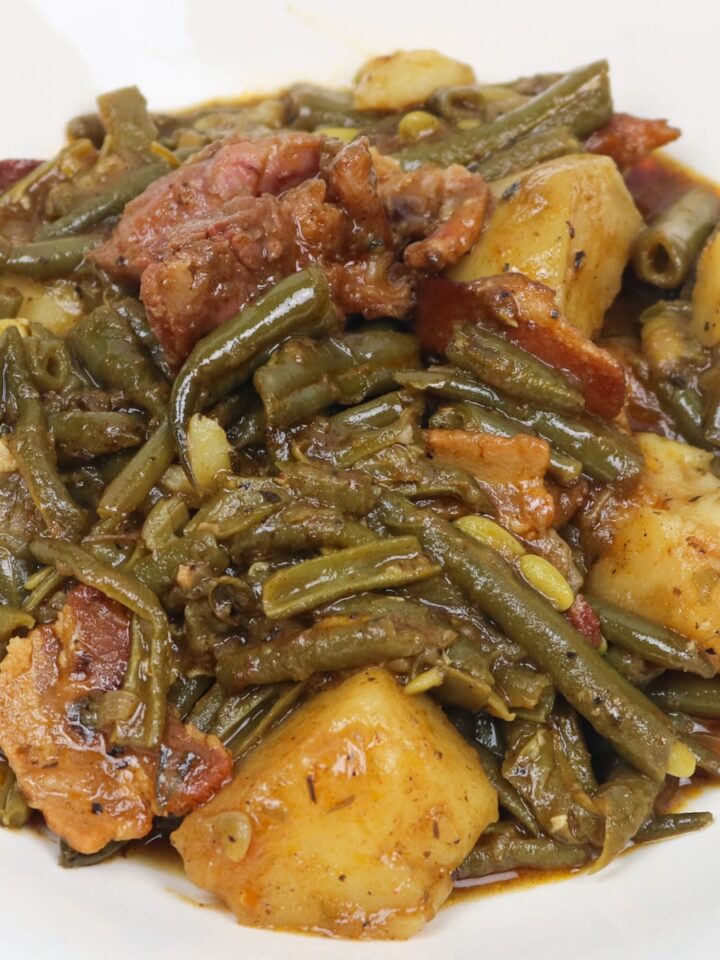
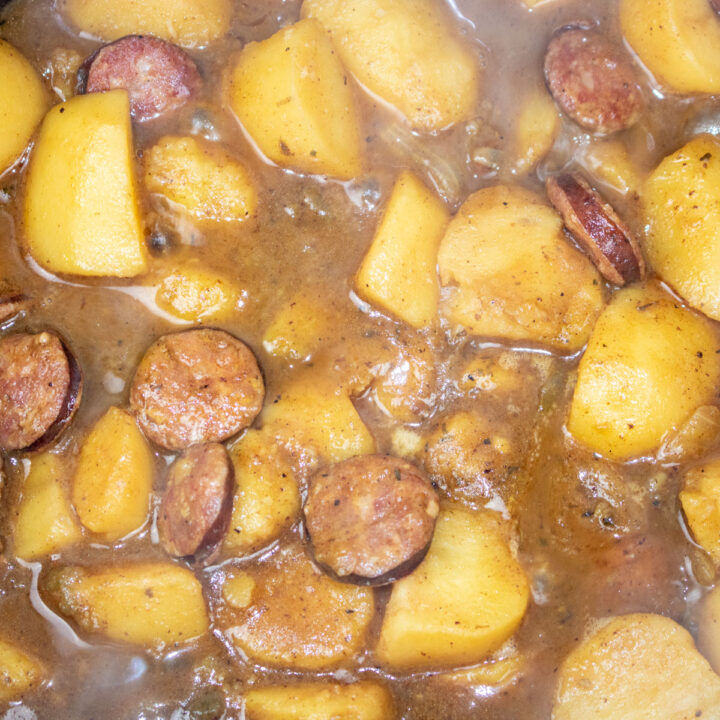
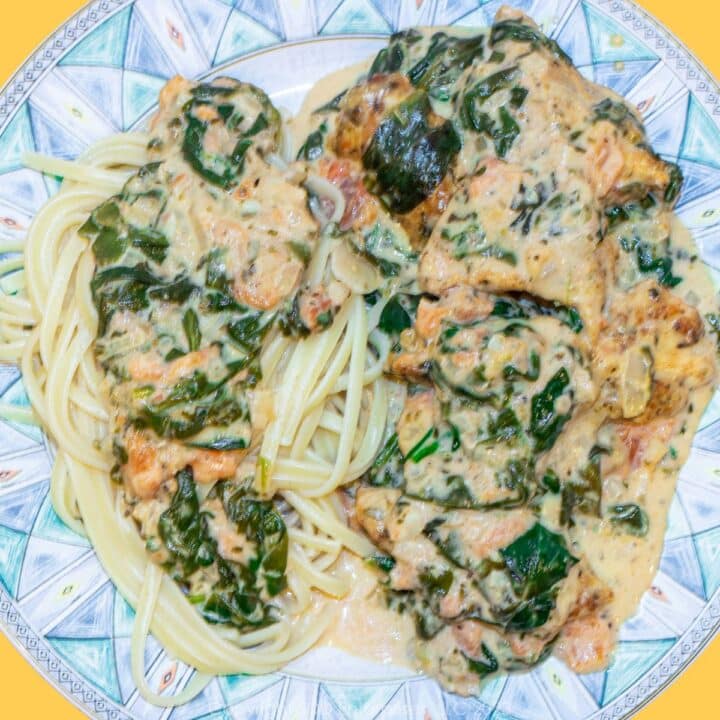
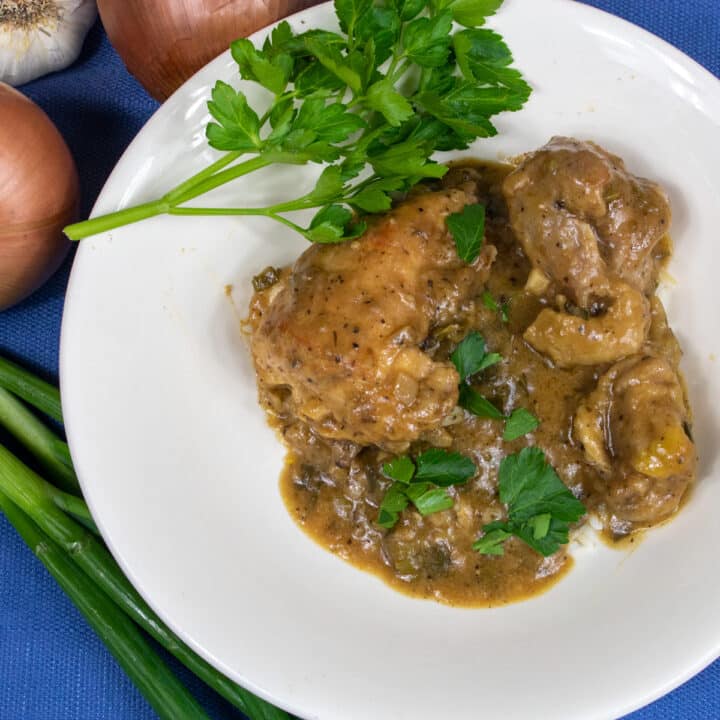
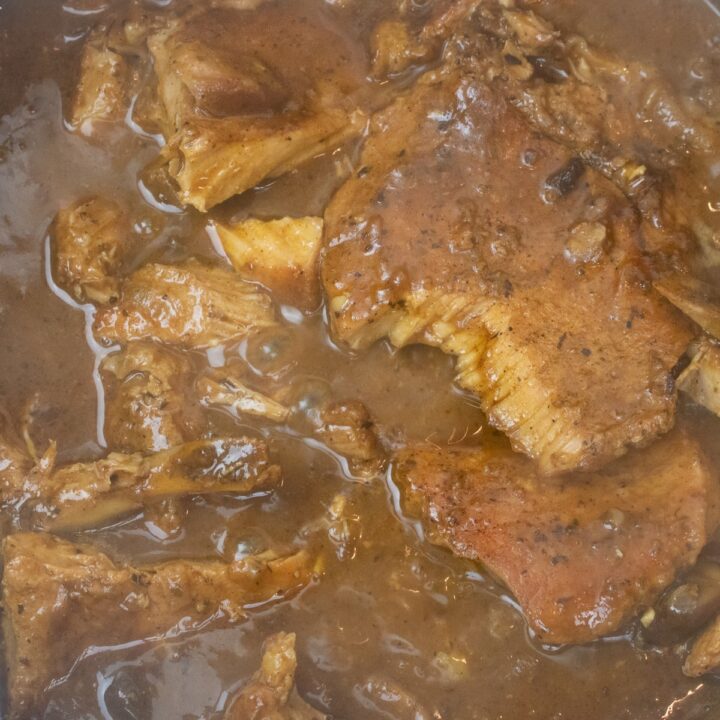

Reba Breaux
I made it this morning. The best my husband and I ever ate and we tried many. I used a whole chicken and andoui sausage. I followed the receipe but just put thee aundi in it. Yummy, can't wait to try your other recipes. Thank you.
Sweet Daddy D
Thanks for trying my recipe, Reba! Some andouille sounds like a great addition! I appreciate you taking the time to tell me about it.
Krig
Please consider replacing Trinity in the recipe instructions with the actual ingredients. If I skip straight to the recipe, save it, or print it, I have no reference for what Trinity refers to.
Sweet Daddy D
Krig, thanks for that suggestion. I've added some clarification in the article and the recipe. I hope that helps.